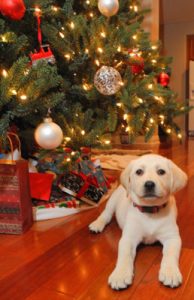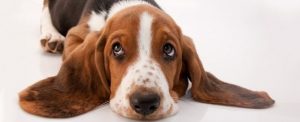
Winter holidays are especially exciting, with all the sparkly lights and streamers, delicate ornaments and brightly colored garland, and don’t get us started on the candies and treats! All of these things are great fun, and no less so for our pets. So, before you start taking out the decorations, take a few minutes to consider how their placement will affect your pets.
Christmas Tree Tips
It can be very difficult to keep a young, still-in-training pet away from the Christmas tree, particularly if this is his first Christmas. Even for an older pet, who may have learned not to jump on the tree — either because it fell on him last year or because your admonitions worked — you will still need to be cautious with the ornaments you place within his reach.
A live tree can be especially hazardous. Dogs and cats like to chew on sticks (i.e., limbs) and greenery, and the fir tree oils can be irritating to the mouth tissue causing such symptoms as drooling and vomiting. Also, if your pet is chewing on the branches, there is a good chance he is also swallowing some of the needles. If enough needles are swallowed they can get caught in the intestinal tract, puncturing the lining or bunching together and causing obstruction. Both can have deadly consequences.
A popular tree decoration called flocking, an imitation snow product, can also cause serious problems when significant amounts of it are swallowed. If you are going to have a tree in your home, it is best to at least get a non-flocked tree.
In addition, some trees are treated with chemical preservatives to keep them fresh longer. These chemicals leach into the water in the feeding dish, making the water poisonous to drink — which pets will do if the water is left uncovered. If you do not have a tree skirt to cover the water dish with, you can use towel, plastic wrap, or aluminum foil.
All That Glitters
Christmas lights should be positioned away from the very bottom of the tree unless you are sure that your pet has been successfully trained not to chew on the cords. Electric cord injuries are very damaging to the mouth tissue and can lead to long term problems with eating, amongst other issues. Check the electric light cords frequently for signs of chewing.
Just to protect your pet and yourself from excitable accidents, hang your delicate and treasured ornaments on the uppermost branches of the tree, and secure them to the branches tightly. In general, it is easier on the whole household if you select tree ornaments that are not likely to shatter. For delicate, glass or treasured ornaments, you might consider creating an area where they can be displayed that is out of reach for your dog or cat, such as from a garland that is hung across a mantel or window. Tinsel, for all its glittery prettiness, is one of the most dangerous tree decorations you can choose. If your pet ingests even a few strands of tinsel — and pets do this more often than you might guess — she is highly likely to suffer the ill, and even deadly effects of an intestinal obstruction. Same goes for edible ornaments, such as popcorn and cranberry strings and candy canes. Leave these things off your tree or your pet will be climbing the tree to get to them.
Other tree decorations that can be hazardous to pets (and children, for that matter) include angel hair — a spun glass or pvc decoration, garland, lit candles, mistletoe, poinsettia plants, and holly berries. Decorations that are not a part of tree trimming, but that are also worth mentioning are advent calendars, in which candy is placed in the small numbered cubbies; and liquid potpourri, which can be spilled or ingested.
It is safest to stick to artificial plants and plastic or unbreakable ornaments, just to be on the safe side. When you can rest in the knowledge that you have done everything to make sure your pet cannot be harmed, then everyone can share in a happy, healthy holiday season together.
 ~At Heart Arrow We Love Pets~
~At Heart Arrow We Love Pets~

